Husqvarna CTH151 User Manual
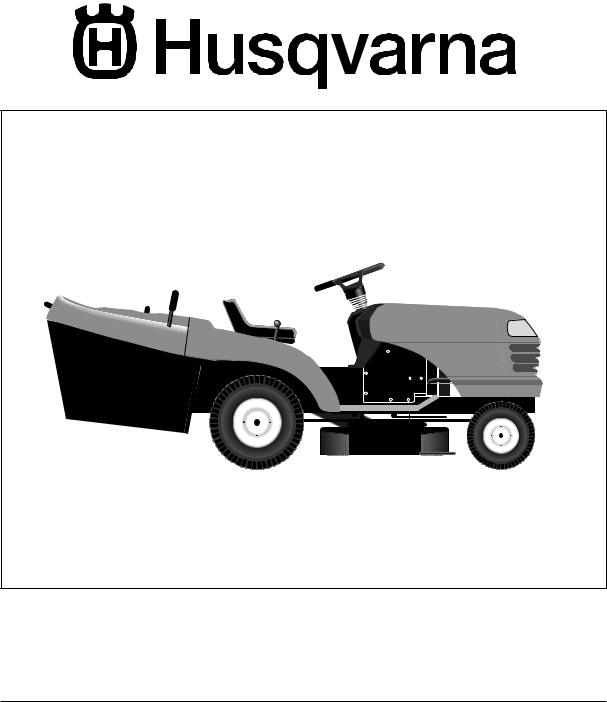
02595 |
CTH151 |
Owner's Manual

SAFETY RULES
Safe Operation Practices for Ride-On Mowers
IMPORTANT: THIS CUTTING MACHINE IS CAPABLE OF AMPUTATING HANDS AND FEET AND THROWING OBJECTS. FAILURE TO OBSERVE THE FOLLOWING SAFETY INSTRUCTIONS COULD RESULT IN SERIOUS INJURY OR DEATH.
I. GENERAL OPERATION
•Read, understand, and follow all instructions in the manual and on the machine before starting.
•Only allow responsible adults, who are familiar with the instructions, to operate the machine.
•Clear the area of objects such as rocks, toys, wire, etc., which could be picked up and thrown by the blade.
•Be sure the area is clear of other people before mowing. Stop machine if anyone enters the area.
•Never carry passengers.
•Do not mow in reverse unless absolutely necessary. Always look down and behind before and while backing.
•Be aware of the mower discharge direction and do not point it at anyone. Do not operate the mower without either the entire grass catcher or the guard in place.
•Slow down before turning.
•Never leave a running machine unattended. Always turn off blades, set parking brake, stop engine, and remove keys before dismounting.
•Turn off blades when not mowing.
•Stop engine before removing grass catcher or unclogging chute.
•Mow only in daylight or good artificial light.
•Do not operate the machine while under the influence of alcohol or drugs.
•Watch for traffic when operating near or crossing roadways.
•Use extra care when loading or unloading the machine into a trailer or truck.
•Data indicates that operators, age 60 years and above, are involved in a large percentage of riding mower-re- lated injuries. These operators should evaluate their ability to operate the riding mower safely enough to protect themselves and others from serious injury.
•Keep machine free of grass , leaves or other debris build-up which can touch hot exhaust / engine parts and burn. Do not allow the mower deck to plow leaves or other debris which can cause build-up to occur. Clean any oil or fuel spillage before operating or storing the machine. Allow machine to cool before storage.
II. SLOPE OPERATION
Slopes are a major factor related to loss-of-control and tipover accidents, which can result in severe injury or death. All slopes require extra caution. If you cannot back up the slope or if you feel uneasy on it, do not mow it.
DO:
•Mow up and down slopes, not across.
•Remove obstacles such as rocks, tree limbs, etc.
•Watch for holes, ruts, or bumps. Uneven terrain could overturn the machine. Tall grass can hide obstacles.
•Use slow speed. Choose a low gear so that you will not have to stop or shift while on the slope.
•Follow the manufacturer’s recommendations for wheel weights or counterweights to improve stability.
•Use extra care with grass catchers or other attachments. These can change the stability of the machine.
•Keep all movement on the slopes slow and gradual. Do not make sudden changes in speed or direction.
•Avoid starting or stopping on a slope. If tires lose traction, disengage the blades and proceed slowly straight down the slope.
DO NOT:
•Do not turn on slopes unless necessary, and then, turn slowly and gradually downhill, if possible.
•Do not mow near drop-offs, ditches, or embankments. The mower could suddenly turn over if a wheel is over the edge of a cliff or ditch, or if an edge caves in.
•Do not mow on wet grass. Reduced traction could cause sliding.
•Do not try to stabilize the machine by putting your foot on the ground.
•Do not use grass catcher on steep slopes.
III. CHILDREN
Tragic accidents can occur if the operator is not alert to the presence of children. Children are often attracted to the machine and the mowing activity. Never assume that children will remain where you last saw them.
•Keep children out of the mowing area and under the watchful care of another responsible adult.
•Be alert and turn machine off if children enter the area.
•Before and when backing, look behind and down for small children.
•Never carry children. They may fall off and be seriously injured or interfere with safe machine operation.
•Never allow children to operate the machine.
•Use extra care when approaching blind corners, shrubs, trees, or other objects that may obscure vision.
IV. SERVICE
•Use extra care in handling gasoline and other fuels. They are flammable and vapors are explosive.
-Use only an approved container.
-Never remove gas cap or add fuel with the engine running. Allow engine to cool before refueling. Do not smoke.
-Never refuel the machine indoors.
-Never store the machine or fuel container inside where there is an open flame, such as a water heater.
•Never run a machine inside a closed area.
•Keep nuts and bolts, especially blade attachment bolts, tight and keep equipment in good condition.
•Never tamper with safety devices. Check their proper operation regularly.
•Keep machine free of grass, leaves, or other debris build-up. Clean oil or fuel spillage. Allow machine to cool before storing.
•Stop and inspect the equipment if you strike an object. Repair, if necessary, before restarting.
•Never make adjustments or repairs with the engine running.
•Grass catcher components are subject to wear, damage, and deterioration, which could expose moving parts or allow objects to be thrown. Frequently check components and replace with manufacturer's recommended parts, when necessary.
•Mower blades are sharp and can cut. Wrap the blade(s) or wear gloves, and use extra caution when servicing them.
•Check brake operation frequently. Adjust and service as required.
2
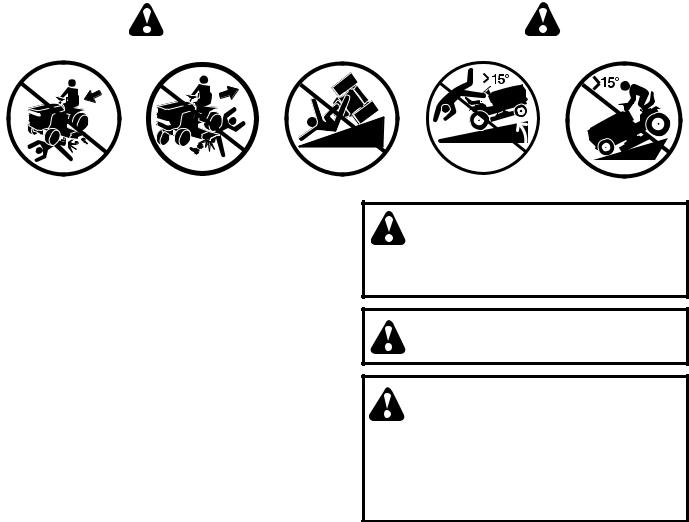
SAFETY RULES
Safe Operation Practices for Ride-On Mowers
•Be sure the area is clear of other people before mowing. Stop machine if anyone enters the area.
•Never carry passengers or children even with the blades off.
•Do not mow in reverse unless absolutely necessary. Always look down and behind before and while backing.
•Never carry children.They may fall off and be seriously injured or interfere with safe machine operation.
•Keep children out of the mowing area and under the watchful care of another responsible adult.
•Be alert and turn machine off if children enter the area.
•Before and when backing, look behind and down for small children.
•Mow up and down slopes (15° Max), not across.
•Remove obstacles such as rocks, tree limbs, etc.
•Watch for holes, ruts, or bumps.Uneven terrain could overturn the machine. Tall grass can hide obstacles.
•Use slow speed. Choose a low gear so that you will not have to stop or shift while on the slope.
•Avoid starting or stopping on a slope. If tires lose traction, disengage the blades and proceed slowly straight down the slope.
•If machine stops while going uphill, disengage blades, shift into reverse and back down slowly.
•Do not turn on slopes unless necessary, and then, turn slowly and gradually downhill, if possible.
WARNING: In order to prevent accidental starting when setting up, transporting, adjusting or making repairs, always disconnect spark plug wire and place wire where it cannot contact spark plug.
WARNING: Do not coast down a hill in neutral, you may lose control of the tractor.
WARNING: Tow only the attachments that are recommended by and comply with specifications of the manufacturer of your tractor. Use common sense when towing. Operate only at the lowest possible speed when on a slope. Too heavy of a load, while on a slope, is dangerous. Tires can lose traction with the ground and cause you to lose control of your tractor.
3

PRODUCT SPECIFICATIONS
Gasoline Capacity |
2.0 Gallons |
|
|
and type: |
Unleaded Regular |
||
|
|
||
Oil Type (API-SF-SJ): |
SAE 10W30 (above 32°F) |
||
|
SAE 5W-30 (below 32°F) |
||
Oil Capacity: |
3.0 Pints |
|
|
|
|
||
Spark Plug: |
Champion RC12YC |
||
(Gap: .030") |
|
|
|
Ground Speed (MPH): |
Forward: 0-5.5 |
||
|
Reverse: 0-2.4 |
||
|
|
|
|
Tire Pressure: |
Front: |
14 PSI |
|
|
Rear: |
10 PSI |
|
|
|
||
Charging System: |
15 Amps @ 3600 RPM |
||
|
|
|
|
Battery: |
AMP/HR: |
35 |
|
|
MIN. CCA: |
280 |
|
|
CASE SIZE:U1R |
||
Blade Bolt Torque: |
27–35 FT. LBS. |
||
CONGRATULATIONS on your purchase of a new tractor. It has been designed, engineered and manufactured to give you the best possible dependability and performance.
Should you experience any problem you cannot easily remedy, please contact your nearest authorized service center. We have competent, well-trained technicians and the proper tools to service or repair this tractor.
Please read and retain this manual. The instructions will enable you to assemble and maintain your tractor properly. Always observe the "SAFETY RULES".
CUSTOMER RESPONSIBILITIES
•Read and observe the safety rules.
•Follow a regular schedule in maintaining, caring for and using your tractor.
•Follow the instructions under the "Maintenance" and "Storage" sections of this owner's manual.
WARNING: This tractor is equipped with an internal combustion engine and should not be used on or near any unimproved forest-covered, brush-covered or grass-covered land unless the engine's exhaust system is equipped with a spark arrester meeting applicable local or state laws (if any). If a spark arrester is used, it should be maintained in effective working order by the operator.
A spark arrester for the muffler is available through your nearest authorized service center/department (See REPAIR PARTS section of this manual).
TABLE OF CONTENTS
SAFETY RULES ......................................................... |
2-3 |
PRODUCT SPECIFICATIONS ....................................... |
4 |
CUSTOMER RESPONSIBILITIES................................. |
4 |
ASSEMBLY ............................................................... |
6-10 |
OPERATION ........................................................... |
11-17 |
MAINTENANCE SCHEDULE ...................................... |
18 |
MAINTENANCE ...................................................... |
18-21 |
SERVICE AND ADJUSTMENTS ............................ |
22-25 |
STORAGE .................................................................... |
26 |
TROUBLESHOOTING ............................................ |
27-28 |
REPAIR PARTS - TRACTOR .................................. |
30-46 |
4
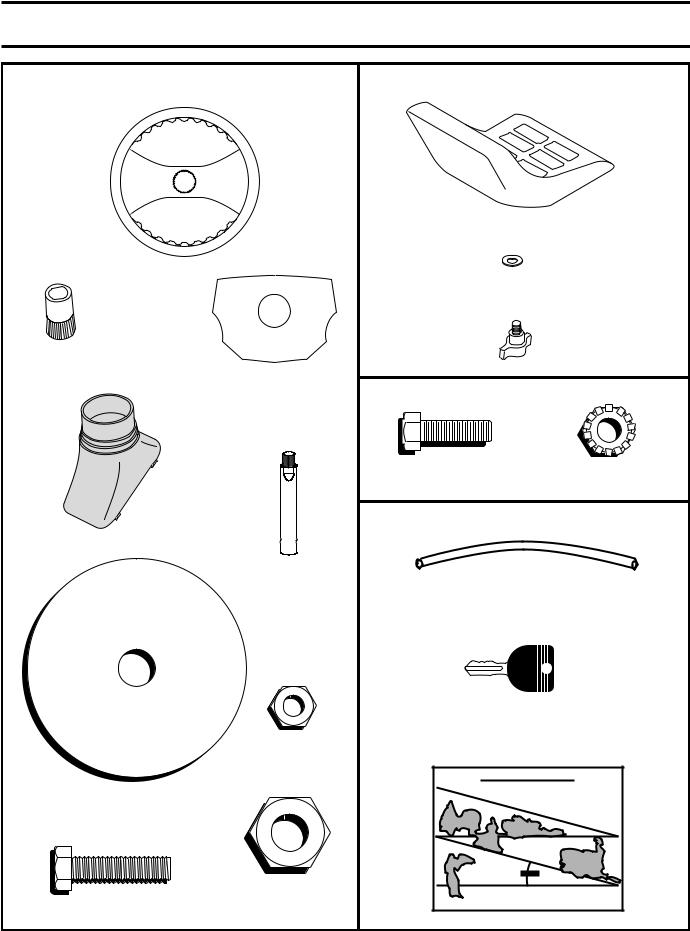
UNASSEMBLED PARTS
Steering Wheel |
|
|
Seat |
|
|
|
(1) Washer |
|
|
|
17/32 x 1-3/16 x 12 |
|
|
|
Gauge |
Steering |
|
|
|
Wheel |
|
|
|
Adapter |
|
|
(1) Bolt |
|
|
|
|
|
Steering |
|
|
|
Wheel |
Battery |
|
|
Insert |
||
|
|
(2) Hex Bolts 1/4-20 x 3/4 |
(2) Keps Nut 1/4-20 |
Steering |
|
|
|
Boot |
|
|
|
|
Steering |
(1) Oil Drain Tube |
|
|
Extension |
||
|
For Future Use |
||
|
Shaft |
||
|
|
|
|
|
|
|
Key |
|
|
(2) Keys |
|
|
(1) Locknut |
Slope Sheet |
|
|
1/4-28 |
||
(1) Large Flat |
|
|
|
Washer |
|
|
|
|
(1) Locknut |
|
|
(1) Hex Bolt 1/4-28 x 1-1/4 |
1/2-20 |
|
|
|
|
|
|
|
|
5 |
|
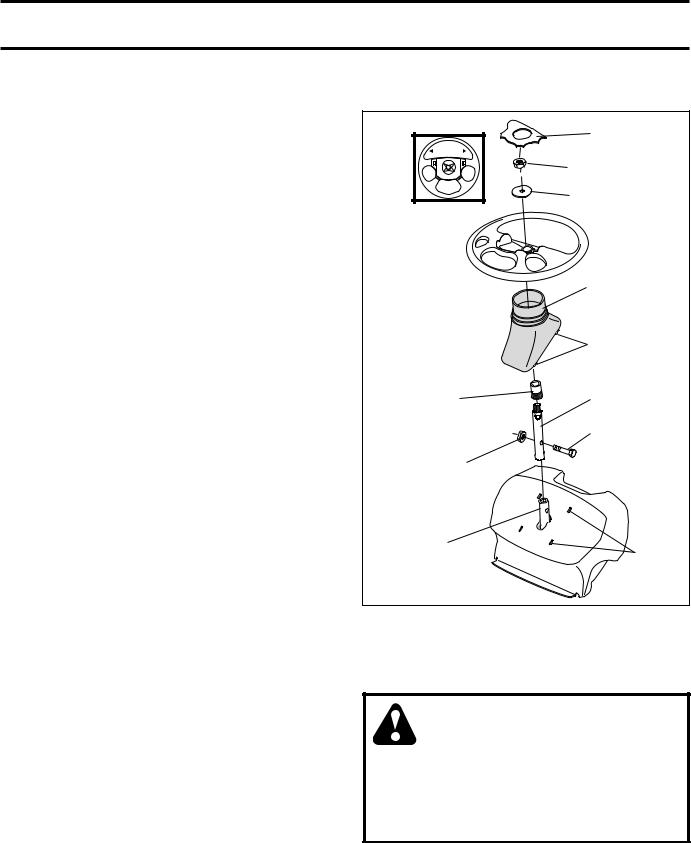
ASSEMBLY
Your new tractor has been assembled at the factory with exception of those parts left unassembled for shipping purposes. To ensure safe and proper operation of your tractor all parts and hardware you assemble must be tightened securely. Use the correct tools as necessary to insure proper tightness.
TOOLS REQUIRED FOR ASSEMBLY
A socket wrench set will make assembly easier. Standard wrench sizes are listed.
(2) |
7/16" wrenches |
Utility knife |
(1) |
3/4" wrenches |
Tire pressure gauge |
Pliers
When right or left hand is mentioned in this manual, it means when you are in the operating position (seated behind the steering wheel).
TO REMOVE TRACTOR FROM CARTON
UNPACK CARTON
•Remove all accessible loose parts and parts cartons from carton.
•Cut along dotted lines on all four panels of carton. Remove end panels and lay side panels flat.
•Check for any additional loose parts or cartons and remove.
BEFORE REMOVING TRACTOR FROM SKID
ATTACH STEERING WHEEL (See Fig. 1)
ASSEMBLE EXTENSION SHAFT AND BOOT
•Slide extension shaft onto lower steering shaft. Align mounting holes in extension and lower shafts and install 1/4 hex bolt and locknut. Tighten securely.
IMPORTANT: TIGHTEN BOLT AND NUT SECURELY TO 10-12 FT. LBS TORQUE.
•Place tabs of steering boot over tab slots in dash and push down to secure.
INSTALL STEERING WHEEL
•Position front wheels of the tractor so they are pointing straight forward.
•Remove steering wheel adapter from steering wheel and slide adapter onto steering shaft extension.
•Position steering wheel so cross bars are horizontal (left to right) and slide inside boot and onto adapter.
•Assemble large flat washer, 1/2 hex nut and tighten securely.
•Snap steering wheel insert into center of steering wheel.
•Remove protective materials from tractor hood and grill.
IMPORTANT: CHECK FOR AND REMOVE ANY STAPLES IN SKID THAT MAY PUNCTURE TIRES WHERE TRACTOR IS TO ROLL OFF SKID.
INSERT
1/2 HEX NUT
LARGE FLAT
WASHER
STEERING
WHEEL 
STEERING
BOOT
TABS
EXTENSION SHAFT
ADAPTER
1/4 HEX BOLT
1/4 LOCKNUT
LOWER |
|
TAB |
|
STEERING |
02601 |
||
SHAFT |
SLOTS |
||
|
FIG. 1
HOW TO SET UP YOUR TRACTOR
CONNECT BATTERY (See Figs. 2)
CAUTION: Do not short battery terminals by allowing a wrench or any other object to contact both terminals at the same time. Before connecting battery, remove metal bracelets, wristwatch bands, rings, etc.
Positive terminal must be connected first to prevent sparking from accidental grounding.
•If this battery is put into service after month and year indicated on label (label located between terminals) charge battery for minimum of one hour at 6-10 amps. (See "BATTERY" in the Maintenance section of this manual for charging instructions).
6

ASSEMBLY
•Remove battery cover.
•Remove terminal protective caps and discard.
•First connect RED battery cable to positive (+) terminal with hex bolt and keps nut as shown. Tighten securely.
•Connect BLACK grounding cable to negative (-) terminal with remaining hex bolt and keps nut. Tighten securely.
•Replace battery cover.
Open battery cover for:
•Inspection for secure connections (to tighten hardware).
•Inspection for corrosion.
•Testing battery.
•Jumping (if required).
•Periodic charging .
BATTERY
COVER 
DISCARD TERMINAL |
|
NEGATIVE |
PROTECTIVE CAPS |
KEPS |
CABLE (BLACK) |
|
NUT |
|
HEX BOLT
POSITIVE CABLE |
|
|
(RED) |
025 |
|
|
91 |
|
|
|
FIG. 2
INSTALL SEAT (See Fig. 3)
Adjust seat before tightening adjustment knob.
•Remove adjustment knob and flat washer securing seat to cardboard packing and set aside for assembly of seat to tractor.
•Pivot seat upward and remove from the cardboard packing. Remove the cardboard packing and discard.
•Place seat on seat pan so head of shoulder bolt is positioned over large slotted hole in pan.
•Push down on seat to engage shoulder bolt in slot and pull seat towards rear of tractor.
•Pivot seat and pan forward and assemble adjustment knob and flat washer loosely. Do not tighten.
•Lower seat into operating position and sit on seat.
•Slide seat until a comfortable position is reached which allows you to press clutch/brake pedal all the way down.
•Get off seat without moving its adjusted position.
•Raise seat and tighten adjustment knob securely.
SEAT |
SEAT PAN |
SHOULDER BOLT |
2466 |
FLAT WASHER |
02464 |
ADJUSTMENT KNOB |
FIG. 3
NOTE: You may now roll or drive your tractor off the skid. Follow the appropriate instruction below to remove the tractor from the skid.
TO ROLL TRACTOR OFF SKID (See Operation section, for location and function of controls)
•Press lift lever plunger and raise attachment lift lever to its highest position.
•Release parking brake by depressing clutch/brake pedal.
•Place freewheel control in freewheeling position to disengage transmission (See “TO TRANSPORT” in the Operation section of this manual).
•Roll tractor forward off skid.
•Remove banding holding deflector shield up against tractor.
TO DRIVE TRACTOR OFF SKID (See Operation section, for location and function of controls)
 WARNING: Before starting, read, understand and follow all instructions in the Operation section of this manual. Be sure tractor is in a well-ventilated area. Be sure the area in front of tractor is clear of other people and objects.
WARNING: Before starting, read, understand and follow all instructions in the Operation section of this manual. Be sure tractor is in a well-ventilated area. Be sure the area in front of tractor is clear of other people and objects.
•Be sure all the above assembly steps have been completed.
•Check engine oil level and fill fuel tank with gasoline.
•Place freewheel control in "transmission engaged" position.
•Sit on seat in operating position, depress clutch/brake pedal and set the parking brake.
•Place motion control lever in neutral (N) position.
•Press lift lever plunger and raise attachment lift lever to its highest position.
7
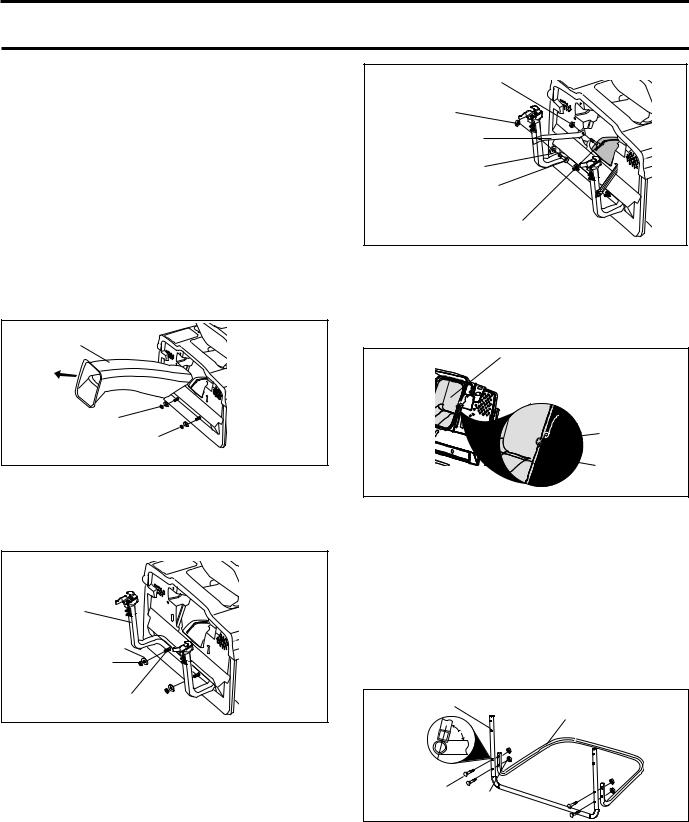
ASSEMBLY
•Start the engine.After engine has started, move throttle control to idle position.
•Release parking brake.
•Slowly move the motion control lever forward and slowly drive tractor off skid.
•Apply brake to stop tractor, set parking brake and place motion control lever in neutral position.
•Turn ignition key to "OFF" position.
Continue with the instructions that follow.
TO INSTALL BAGGER COMPONENTS TO
TRACTOR (See Figs. 4A-4D)
•Remove discharge chute from rear of tractor. Unhook the two (2) straps and pull chute out and away from tractor.
•Remove the two (2) 3/8 nuts and flat washers from the bolts at the tractor back plate.
DISCHARGE
CHUTE
3/8 NUT
FLATWASHER
0 2277
FIG. 4A
•Using the nuts and flat washers removed from tractor back plate, install the bagger support tube to the back plate as shown. Tighten securely.
SUPPORT
TUBE
FLAT
WASHER
3/8 NUT
BOLT |
02330 |
|
FIG. 4B
•Install the two upper support brackets through the back plate and to the chassis, using the 10 x 19 mm (3/8"x3/4") carriage bolts and locknuts supplied.Tighten securely.
•Assemble both support brackets to the outside of the baggger support tube using two each 3/8 x 63,5mm hex bolts13/32" I.D. flat washers and 3/8 locknuts from parts bag. Tighten securely.
•Replace discharge chute into rear opening of tractor. Secure the chute with the two hook straps.
3/8 LOCK NUT
3/8 LOCK NUT
SUPPORT BRACKET
13/32 FLAT WASHER
3/8 HEX BOLT
3/8 CARRIAGE BOLT |
02590 |
|
FIG. 4C
NOTE:The strap hook must go through the discharge chute only. Do not allow the hook to enter the slot in the tractor back plate.This will allow the discharge chute to float with the mower deck when moving on uneven terrain.
DISCHARGE
CHUTE
|
HOOK |
02306 |
BACKPLATE |
SLOT
FIG. 4D
TO ASSEMBLE BAGGER (See Figs. 5 & 6)
NOTE: For ease of assembly, you may wish to obtain the assistance of another person when putting the bagger together.
•Holes in front bagger tube are at an angle. Place front bagger tube against lower bagger tube and check for proper hole alignment before assembling bolts.
•Assemble front and lower bagger tubes using four (4) 1/4 x 50,8mm carriage bolts and lock nuts supplied. Tighten securely.
FRONT BAGGER TUBE
1/4 X 2" |
|
CARRIAGE |
1/4 LOCK |
BOLTS |
|
|
NUT |
LOWER BAGGER TUBE
2 0259
FIG. 5
•Slide front and lower bagger tube assembly into the bagger assemby.
•Assemble front and upper bagger tubes using four (4) 1/4 x 50,8mm carraige bolts and lock nuts supplied. Tighten securely.
8
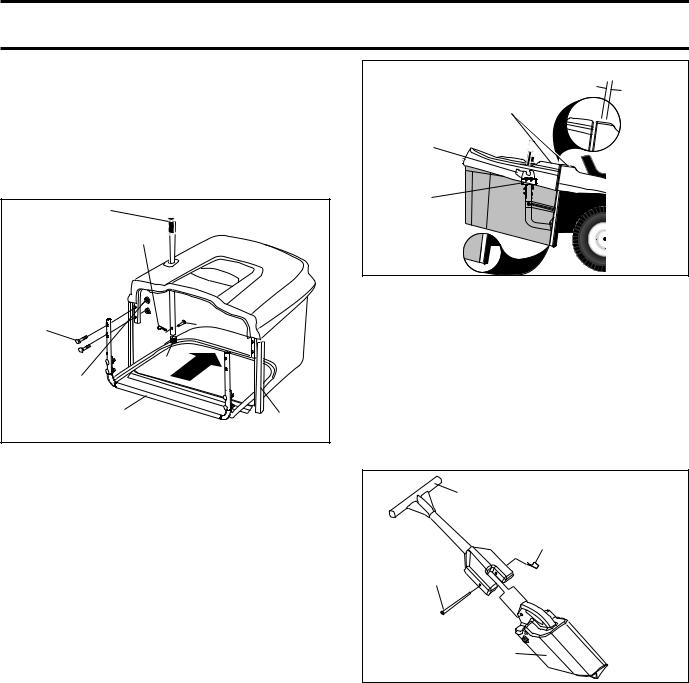
ASSEMBLY
•Slip all the vinyl bindings over the bagger tubes
•Slide the bagger dump handle through the hole in the bagger top, install the clevis pin and secure with retainer spring.
•Push cap over end of bagger dump handle.
NOTE: For future use, the clevis pin may be removed in order to use the handle to clear the chute in the event it has become clogged.
DUMP HANDLE
TUBE
RETAINER
SPRING
1/4 X 2" |
CLEVIS |
CARRIAGE |
|
BOLTS |
PIN |
|
CAP |
1/4 LOCK NUT |
02593 |
|
|
FRONT BAGGER TUBE |
VINYL |
|
BINDING |
FIG. 6
BAGGER ADJUSTMENT (See Fig. 7)
For proper bag function and appearance, it may be necessary to adjust the bagger assembly.There should be 6mm (1/4")-9mm (3/8") gap between the bagger top and fender and the bagger top surface should be even with the top surface of the fender. To adjust bagger position:
HORIZONTAL ADJUSTMENT
•Slightly loosen the nuts securing the bagger RH and LH horizontal adjustment brackets.Loosen only enough so the brackets keep their position, but allow them to be moved.
•Move the brackets the amount forward or backward you wish the bag assembly to move. Retighten the nuts securely.
VERTICAL ADJUSTMENT
•Slightly loosen the nuts securing the vertical adjustment brackets. Loosen only enough so the brackets keep their position, but allow them to be moved.
•Move the brackets the amount up or down you wish the bag assembly to move. Retighten the nuts securely.
•Reinstall the bagger assembly and check the bagger to fender fit. If necessary, repeat the procedure until proper fit is attained.
6MM (1/4") - 9MM (3/8") |
TOP SURFACES |
EVEN |
HORIZONTAL |
ADJUSTMENT |
BRACKET |
VERTICAL |
ADJUSTMENT |
BRACKET |
02329 |
FIG. 7
TO ASSEMBLE AND INSTALL MULCHER
PLUG (See Fig. 8)
•Remove spring retainer and pin from handle.
•Insert plug into handle. Make sure that the letter "A" on both the plug and handle are on the same side and that they can both be seen from the top when laying on the ground.
•Secure with pin and retainer spring provided. For installation see "To Convert Mower" in Section 5 of this manual.
HANDLE
RETAINER
SPRING
A
PIN
A
PLUG
02
21 4
FIG. 8
9

ASSEMBLY
CHECK TIRE PRESSURE
The tires on your tractor were overinflated at the factory for shipping purposes. Correct tire pressure is important for best cutting performance.
•Reduce tire pressure to PSI shown in “PRODUCT SPECIFICATIONS” section of this manual.
CHECK DECK LEVELNESS
For best cutting results, mower housing should be properly leveled. See“TO LEVEL MOWER HOUSING”in the Service and Adjustments section of this manual.
CHECK FOR PROPER POSITION OF ALL BELTS
See the figures that are shown for replacing motion and mower blade drive belts in the Service and Adjustments section of this manual. Verify that the belts are routed correctly.
CHECK BRAKE SYSTEM
After you learn how to operate your tractor, check to see that the brake is properly adjusted. See “TO ADJUST BRAKE” in the Service and Adjustments section of this manual.
CHECKLIST
BEFOREYOU OPERATE AND ENJOYYOUR NEW TRACTOR, WE WISH TO ASSURE THAT YOU RECEIVE THE BEST PERFORMANCE AND SATISFACTION FROMTHIS QUALITY PRODUCT.
PLEASE REVIEW THE FOLLOWING CHECKLIST:
All assembly instructions have been completed.
No remaining loose parts in carton.
Battery is properly prepared and charged. (Minimum 1 hour at 6 amps).
Seat is adjusted comfortably and tightened securely.
All tires are properly inflated. (For shipping purposes, the tires were overinflated at the factory).
Be sure mower deck is properly leveled side-to-side/ front-to-rear for best cutting results. (Tires must be properly inflated for leveling).
Check mower and drive belts. Be sure they are routed properly around pulleys and inside all belt keepers.
Check wiring. See that all connections are still secure and wires are properly clamped.
Before driving tractor, be sure freewheel control is in drive position.
WHILE LEARNING HOW TO USE YOUR TRACTOR, PAY EXTRA ATTENTION TO THE FOLLOWING IMPORTANT ITEMS:
Engine oil is at proper level.
Fuel tank is filled with fresh, clean, regular unleaded gasoline.
Become familiar with all controls - their location and function. Operate them before you start the engine.
Be sure brake system is in safe operating condition.
It is important to purge the transmission before operating your tractor for the first time. Follow proper starting and transmission purging instructions (See “TO START ENGINE” and “PURGE TRANSMISSION” in the Operation section of this manual).
10
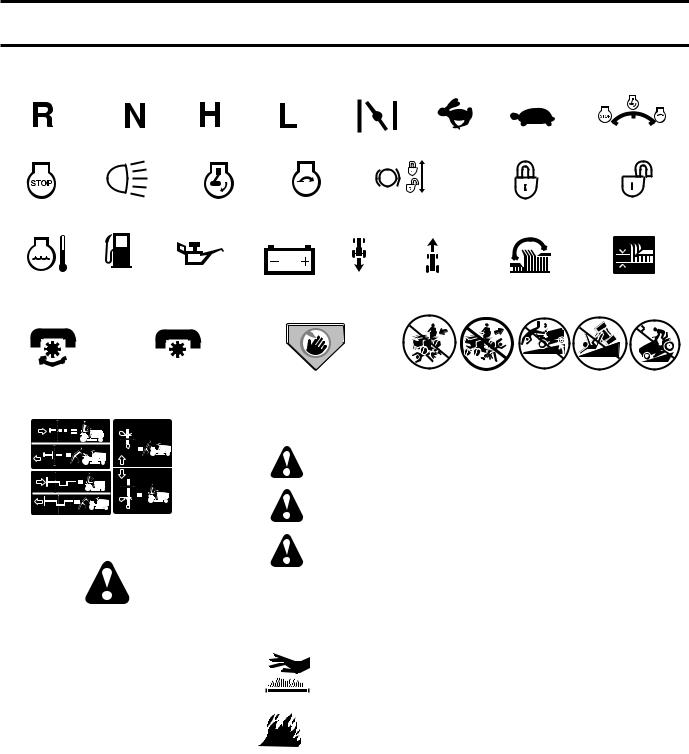
OPERATION
These symbols may appear on your tractor or in literature supplied with the product. Learn and understand their meaning.
REVERSE |
NEUTRAL |
HIGH |
LOW |
CHOKE |
FAST |
|
SLOW |
IGNITION |
|
|
|
|
|
|
P |
|
|
|
|
ENGINE OFF |
LIGHTS ON |
|
ENGINE ON |
ENGINE START PARKING BRAKE |
PARKING BRAKE |
PARKING BRAKE |
|||
|
|
|
|
|
|
|
LOCKED |
UNLOCKED |
|
OVER TEMP |
FUEL |
OIL PRESSURE |
BATTERY |
REVERSE |
FORWARD |
MOWER HEIGHT |
MOWER LIFT |
||
LIGHT |
|
|
|
|
|
|
|
|
|
|
|
|
|
|
|
|
|
15 |
15 |
|
|
|
|
|
|
|
|
|
|
ATTACHMENT |
ATTACHMENT |
DANGER, KEEP HANDS |
KEEP AREA CLEAR |
SLOPE HAZARDS |
|||||
CLUTCH ENGAGED CLUTCH DISENGAGED |
|||||||||
|
|
|
|
AND FEET AWAY |
(SEE SAFETY RULES SECTION) |
||||
FREE WHEEL (Automatic Models only)
Failure to follow instructions could result in serious injury or death. The safety alert symbol is used to identify safety information about hazards which can result in death, serious injury and/or property damage.
DANGER indicates a hazard which, if not avoided, will result in death or serious injury.
WARNING indicates a hazard which, if not avoided, could result in death or serious injury.
CAUTION indicates a hazard which, if not avoided, might result in minor or moderate injury.
CAUTION when used without the alert symbol, indicates a situation that could result in damage to the tractor and/or engine.
HOT SURFACES indicates a hazard which,
if not avoided, could result in death, serious injury and/or property damage.
FIRE indicates a hazard which, if not avoided, could result in death, serious injury and/or property damage.
11
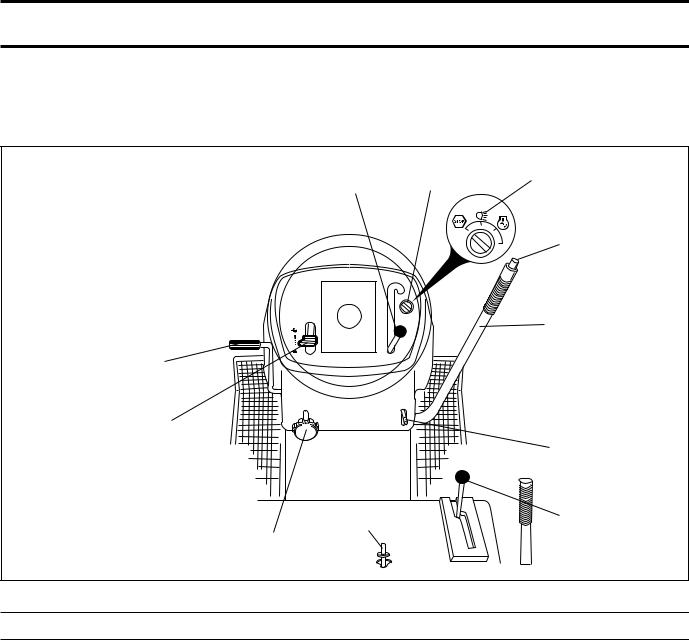
OPERATION
KNOW YOUR TRACTOR
READ THIS OWNER'S MANUAL AND SAFETY RULES BEFORE OPERATING YOUR TRACTOR
Compare the illustrations with your tractor to familiarize yourself with the locations of various controls and adjustments. Save this manual for future reference.
ATTACHMENT |
IGNITION |
LIGHT |
CLUTCH LEVER |
SWITCH |
SWITCH |
|
|
POSITION |
LIFT LEVER
PLUNGER
ATTACHMENT
LIFT LEVER
CLUTCH/BRAKE PEDAL
THROTTLE/CHOKE |
|
CONTROL |
PARKING |
|
|
|
BRAKE |
FREEWHEEL |
MOTION |
CONTROL |
CONTROL |
HEIGHT |
LEVER |
|
|
ADJUSTMENT |
|
KNOB |
|
FIG. 9
Our tractors conform to the safety standards of the American National Standards Institute.
ATTACHMENT CLUTCH LEVER - Used to engage the mower blades, or other attachments mounted to your tractor.
LIGHT SWITCH POSITION: Turns the headlights on and off.
THROTTLE/CHOKE CONTROL - Used for starting and controlling engine speed.
CLUTCH/BRAKE PEDAL: Used for declutching and braking the tractor and starting the engine.
PARKING BRAKE:Locks clutch/brake pedal into the brake position.
FREEWHEEL CONTROL: Disengages transmission for pushing or slowly towing the tractor with the engine off.
MOTION CONTROL LEVER: Selects the speed and direction of tractor.
ATTACHMENT LIFT LEVER: Used to raise and lower the mower deck or other attachments mounted to your tractor.
LIFT LEVER PLUNGER: Used to release attachment lift lever when changing its position.
IGNITION SWITCH: Used for starting and stopping the engine.
HEIGHT ADJUSTMENT KNOB - Used to adjust the mower cutting height.
12
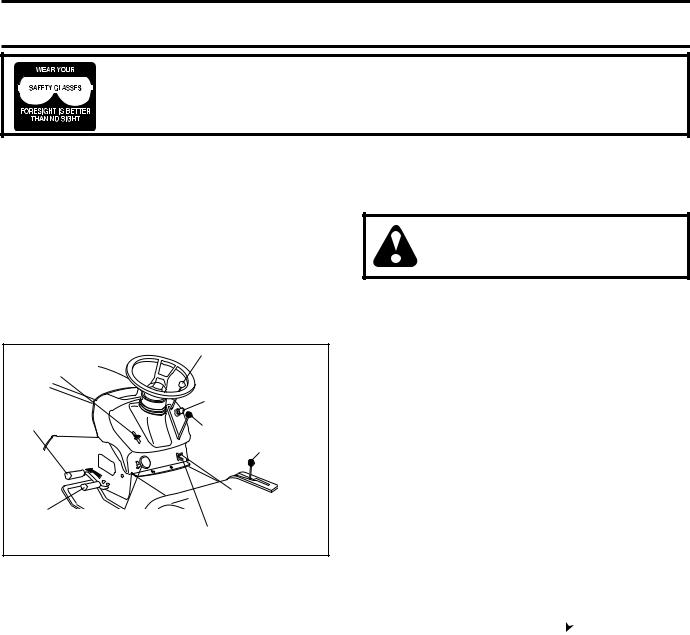
OPERATION
The operation of any tractor can result in foreign objects thrown into the eyes, which can result in severe eye damage. Always wear safety glasses or eye shields while operating your tractor or performing any adjustments or repairs. We recommend a wide vision safety mask over spectacles or standard safety glasses.
00155
HOW TO USE YOUR TRACTOR
TO SET PARKING BRAKE (See Fig. 10)
Your tractor is equipped with an operator presence sensing switch. When engine is running, any attempt by the operator to leave the seat without first setting the parking brake will shut off the engine.
•Depress clutch/brake pedal into full “BRAKE” position and hold.
•Place parking brake lever in “ENGAGED” position and release pressure from clutch/brake pedal. Pedal should remain in “BRAKE” position. Make sure parking brake will hold tractor secure.
THROTTLE/CHOKE |
ATTACHMENT CLUTCH |
|
CONTROL LEVER |
|
LEVER "ENGAGED" |
|
|
POSITION |
|
|
IGNITION |
"BRAKE" |
|
KEY |
POSITION |
|
"DISENGAGED" |
|
|
|
01842 |
|
POSITION MOTION |
|
|
CONTROL |
|
|
LEVER |
|
|
PARKING BRAKE |
CLUTCH/BRAKE |
HEIGHT |
"ENGAGED" |
POSITION |
||
PEDAL "DRIVE" |
ADJUSTMENT PARKING BRAKE |
|
POSITION |
KNOB |
"DISENGAGED" POSITION |
|
|
|
FIG. 10
STOPPING (See Fig. 10)
MOWER BLADES -
•To stop mower blades,move attachment clutch lever to “DISENGAGED” position.
GROUND DRIVE -
•To stop ground drive, depress clutch/brake pedal into full “BRAKE” position.
•Move motion control lever to neutral (N) position.
IMPORTANT: THE MOTION CONTROL LEVER DOES NOT RETURN TO NEUTRAL (N) POSITION WHEN THE CLUTCH/ BRAKE PEDAL IS DEPRESSED.
ENGINE -
•Move throttle control between half and full speed (fast) position.
NOTE: Failure to move throttle control between half and full speed (fast) position, before stopping may cause engine to “backfire”.
•Turn ignition key to “OFF” position and remove key. Always remove key when leaving tractor to prevent unauthorized use.
•Never use choke to stop engine.
IMPORTANT: LEAVING THE IGNITION SWITCH IN ANY POSITION OTHER THAN "OFF" WILL CAUSE THE BATTERY TO BE DISCHARGED, (DEAD).
NOTE: Under certain conditions when tractor is standing idle with the engine running, hot engine exhaust gases may cause “browning” of grass. To eliminate this possibility, always stop engine when stopping tractor on grass areas.
CAUTION: Always stop tractor completely,as described above,before leaving the operator's position; to empty grass catcher, etc.
TO USE THROTTLE CONTROL (See Fig. 10)
Always operate engine at full throttle.
•Operating engine at less than full throttle reduces the battery charging rate.
•Full throttle offers the best bagging and mower performance.
TO MOVE FORWARD AND BACKWARD (See Fig. 10)
The direction and speed of movement is controlled by the motion control lever.
•Start tractor with motion control lever in neutral (N) position.
•Release parking brake.
•Slowly move motion control lever to desired position.
TO ADJUST MOWER CUTTING HEIGHT (See Fig. 10)
The cutting height is controlled by turning the height adjustment knob in desired direction.
•Turn knob clockwise ( ) to raise cutting height.
) to raise cutting height.
•Turn knob counterclockwise ( ) to lower cutting height.
) to lower cutting height.
The cutting height range is approximately 1-1/2" to 4". The heights are measured from the ground to the blade tip with the engine not running. These heights are approximate and may vary depending upon soil conditions, height of grass and types of grass being mowed.
•The average lawn should be cut to approximately 2-1/2 inches during the cool season and to over 3 inches during hot months. For healthier and better looking lawns, mow often and after moderate growth.
•For best cutting performance, grass over 6 inches in height should be mowed twice. Make the first cut relatively high; the second to desired height.
TO ADJUST GAUGE WHEELS (See Fig. 11)
Gauge wheels are properly adjusted when they are slightly off the ground when mower is at the desired cutting height in operating position. Gauge wheels then keep the deck in proper position to help prevent scalping in most terrain conditions.
13
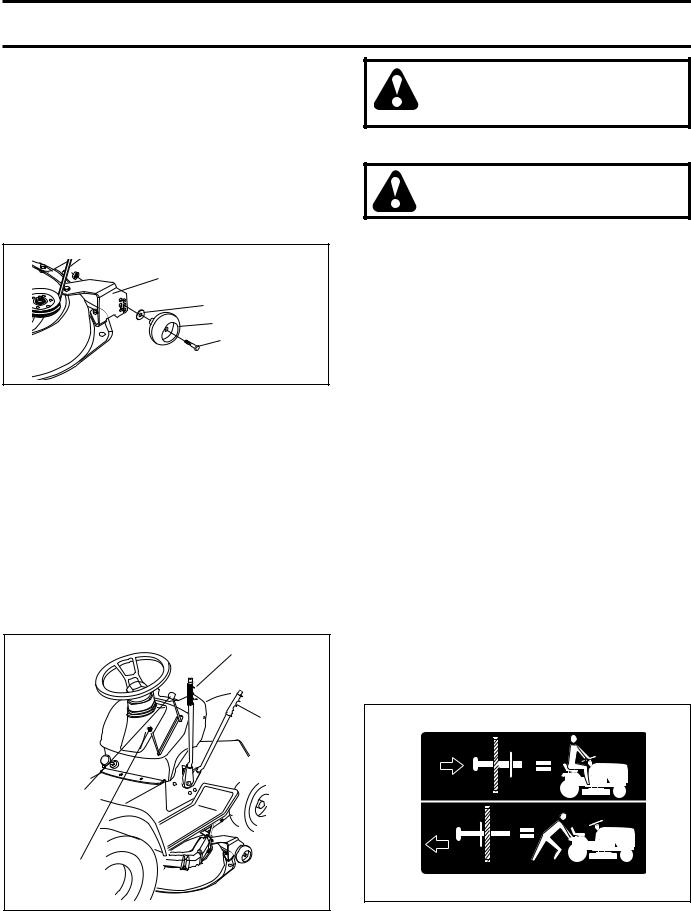
OPERATION
NOTE:Adjust gauge wheels with tractor on a flat level surface.
•Adjust mower to desired cutting height (See “TO ADJUST MOWER CUTTING HEIGHT” in the Operation section of this manual).
•With mower in desired height of cut position, gauge wheels should be assembled so they are slightly off the ground. Install gauge wheel in appropriate hole with shoulder bolt, 3/8 washer, and 3/8-16 locknut and tighten securely.
•Repeat for opposite side installing gauge wheel in same adjustment hole.

 3/8-16 LOCKNUT
3/8-16 LOCKNUT
GAUGE WHEEL
MOUNTING BRACKET
3/8 WASHER
GAUGE WHEEL
SHOULDER BOLT
FIG. 11
TO OPERATE MOWER (See Fig. 12)
Your tractor is equipped with an operator presence sensing switch. Any attempt by the operator to leave the seat with the engine running and the attachment clutch engaged will shut off the engine.You must remain fully and centrally positioned in the seat to prevent the engine from hesitating or cutting off when operating your equipment on rough, rolling terrain or hills.
•Select desired height of cut.
•Lower mower with attachment lift control.
•Start mower blades by engaging attachment clutch control.
•TO STOP MOWER BLADES - disengage attachment clutch control.
ATTACHMENT
LIFT LEVER
HIGH POSITION
LOW
POSITION
ATTACHMENT CLUTCH LEVER "ENGAGED" POSITION
"DISENGAGED" POSITION
02381
FIG. 12
CAUTION: Do not operate the mower without either the entire grass catcher, on mowers so equipped,or the deflector shield in place.
TO OPERATE ON HILLS
WARNING: Do not drive up or down hills with slopes greater than 15° and do not drive across any slope.
•Choose the slowest speed before starting up or down hills.
•Avoid stopping or changing speed on hills.
•If slowing is necessary, move throttle control lever to slower position.
•If stopping is absolutely necessary, push clutch/brake pedal quickly to brake position and engage parking brake.
•Move motion control lever to neutral (N) position.
IMPORTANT: THE MOTION CONTROL LEVER DOES NOT RETURN TO NEUTRAL (N) POSITION WHEN THE CLUTCH/ BRAKE PEDAL IS DEPRESSED.
•To restart movement, slowly release parking brake and clutch/brake pedal.
•Slowly move motion control lever to slowest setting.
•Make all turns slowly.
TO TRANSPORT (See Figs. 9 and 13)
When pushing or towing your tractor, be sure to disengage transmission by placing freewheel control in freewheeling position. Free wheel control is located under the seat.
•Raise attachment lift to highest position with attachment lift control.
•Raise seat and pull freewheel control up and back into the slot and release so it is held in the disengaged position.
•Do not push or tow tractor at more than two (2) MPH.
•To reengage transmission, reverse above procedure.
NOTE: To protect hood from damage when transporting your tractor on a truck or a trailer, be sure hood is closed and secured to tractor. Use an appropriate means of tying hood to tractor (rope, cord, etc.).
Transmission Engaged
02219
Transmission Disengaged
FIG. 13
14
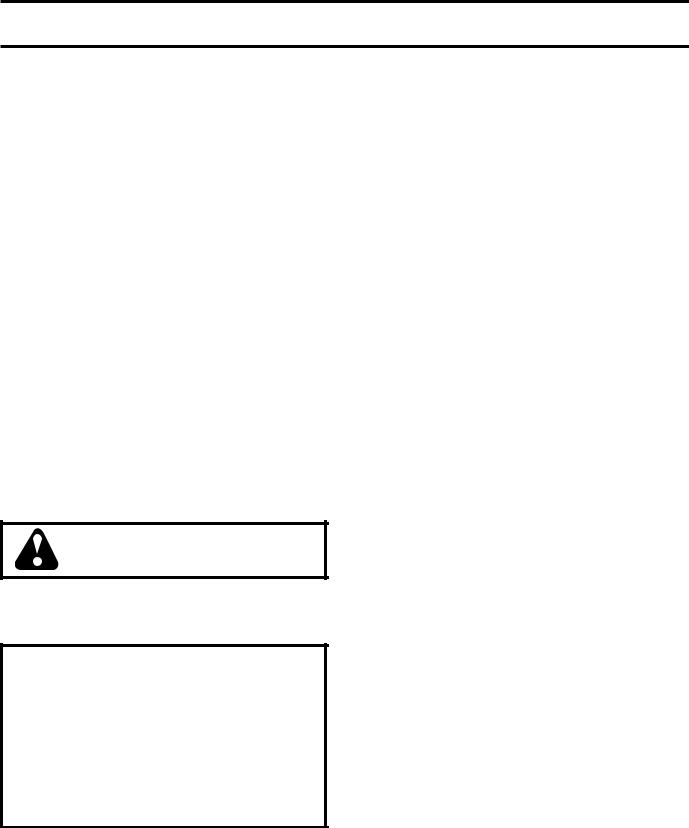
OPERATION
TOWING CARTS AND OTHER ATTACHMENTS
Tow only the attachments that are recommended by and comply with specifications of the manufacturer of your tractor. Use common sense when towing. Too heavy of a load, while on a slope, is dangerous. Tires can lose traction with the ground and cause you to lose control of your tractor.
BEFORE STARTING THE ENGINE
CHECK ENGINE OIL LEVEL
The engine in your tractor has been shipped, from the factory, already filled with summer weight oil.
•Check engine oil with tractor on level ground.
•Pull up and remove oil fill cap/dipstick; wipe oil off. Reinsert the dipstick into the tube and push down firmly into place. Remove and read oil level. If necessary, add oil until “FULL” mark on dipstick is reached. Do not overfill.
•For cold weather operation you should change oil for easier starting (See “OIL VISCOSITY CHART” in the Maintenance section of this manual).
•To change engine oil, see the Maintenance section in this manual.
ADD GASOLINE
•Fill fuel tank to bottom of filler neck. Do not overfill. Use fresh, clean, regular unleaded gasoline with a minimum of 87 octane. (Use of leaded gasoline will increase carbon and lead oxide deposits and reduce valve life). Do not mix oil with gasoline. Purchase fuel in quantities that can be used within 30 days to assure fuel freshness.
CAUTION: Wipe off any spilled oil or fuel. Do not store, spill or use gasoline near an open flame.
IMPORTANT: WHEN OPERATING IN TEMPERATURES BELOW32°F(0°C), USE FRESH, CLEAN WINTER GRADE GASOLINE TO HELP INSURE GOOD COLD WEATHER STARTING.
CAUTION: Alcohol blended fuels (called gasohol or using ethanol or methanol) can attract moisture which leads to separation and formation of acids during storage. Acidic gas can damage the fuel system of an engine while in storage. To avoid engine problems, the fuel system should be emptied before storage of 30 days or longer. Drain the gas tank, start the engine and let it run until the fuel lines and carburetor are empty. Use fresh fuel next season. See Storage Instructions for additional information. Never use engine or carburetor cleaner products in the fuel tank or permanent damage may occur.
TO START ENGINE (See Fig. 9)
When starting the engine for the first time or if the engine has run out of fuel, it will take extra cranking time to move fuel from the tank to the engine.
•Be sure freewheel control is in the transmission engaged position.
•Sit on seat in operating position, depress clutch/brake pedal and set parking brake.
•Place motion control lever in neutral (N) position.
•Move attachment clutch to “DISENGAGED” position.
•Move throttle control to choke position.
NOTE: Before starting, read the warm and cold starting procedures below.
•Insert key into ignition and turn key clockwise to“START” position and release key as soon as engine starts. Do not run starter continuously for more than fifteen seconds per minute. If the engine does not start after several attempts, move throttle control to fast position, wait a few minutes and try again. If engine still does not start, move the throttle control back to the choke position and retry.
WARM WEATHER STARTING (50° F and above)
•When engine starts, move the throttle control to the fast position.
•The attachments and ground drive can now be used. If the engine does not accept the load, restart the engine and allow it to warm up for one minute using the choke as described above.
COLD WEATHER STARTING ( 50° F and below)
•When engine starts, allow engine to run with the throttle control in the choke position until the engine runs roughly, then move throttle control to fast position. This may require an engine warm-up period from several seconds to several minutes, depending on the temperature.
AUTOMATIC TRANSMISSION WARM UP
•Before driving the unit in cold weather, the transmission should be warmed up as follows:
•Be sure the tractor is on level ground.
•Place the motion control lever in neutral. Release the parking brake and let the clutch/brake slowly return to operating position.
•Allow one minute for transmission to warm up.This can be done during the engine warm up period.
•The attachments can also be used during the engine warm-up period after the transmission has been warmed up.
NOTE: If at a high altitude (above 3000 feet) or in cold temperatures (below 32 F) the carburetor fuel mixture may need to be adjusted for best engine performance. See “TO ADJUST CARBURETOR” in the Service and Adjustments section of this manual.
15
